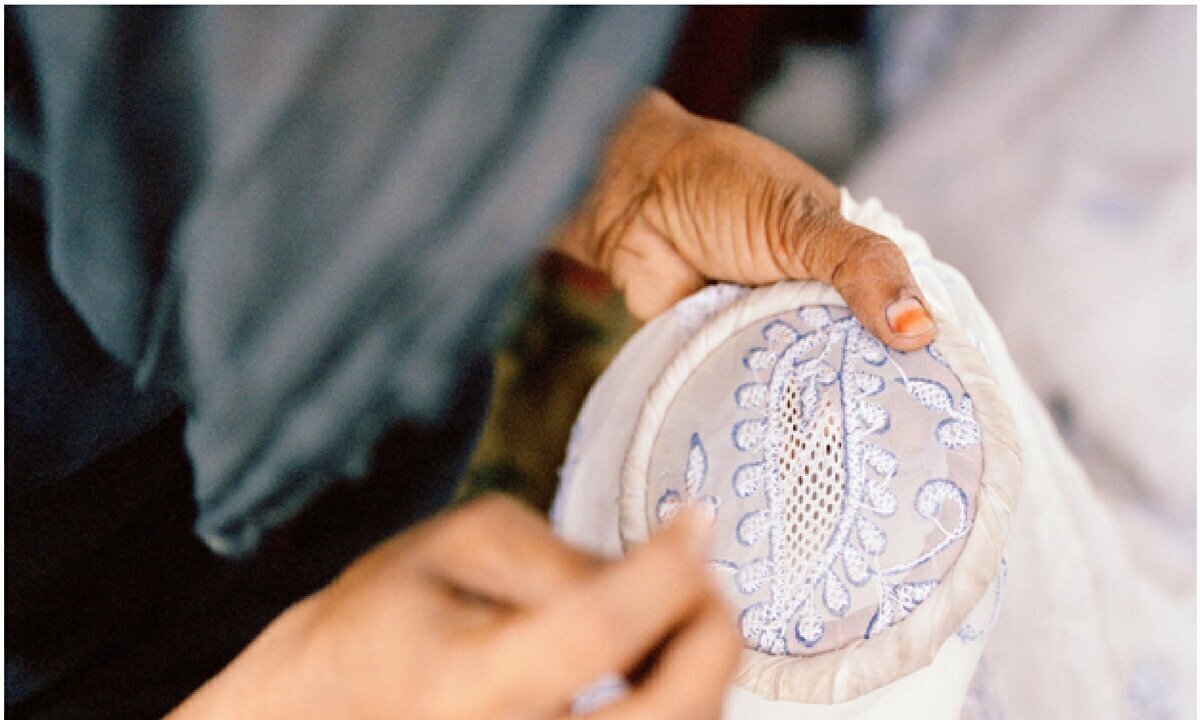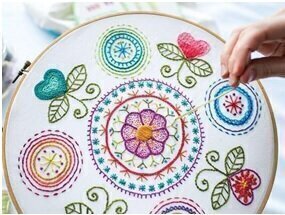Everything You Need to Know About Traditional Lucknowi Embroidery - Chikankari

Chikankari is an eminent craft amongst other handloom specialties of India, which has mesmerized one and all from the royals of yore to trendsetting celebrities of today.
Lucknow- the state capital of Uttar Pradesh, India is world renowned for its traditional Chikankari embroidery. There are thousands of families involved in Chikankari embroidery in and around villages of Lucknow. Nearly 90% of its work is done by women professionally. After Lucknow other cities like Delhi and Mumbai are the other centers for Chikankari work.
Origin & History of Chikankari Embroidery
Chikankari is also called shadow work. It is said to be derived from a Persian word 'Chakin' which means creating delicate patterns on a fabric. However, there are theories that connect this craft to Bengal, where the word means ‘Fine’. There's yet another story where the word is said to be a version of 'Chikeen' or ‘Sequin’, which referred to a coin valuing Rs 4 for which the work was sold in the past.
There are many references of Indian Chikankari dating back to ancient times, as old as 3rd Century BC. Megasthenes, a Greek traveller, mentioned the use of flowered muslins by Indians in his writings.
There are also multiple stories regarding the Origin of Chikankari in India, which all differ a lot. In one of these stories, apparently a traveller was passing through a village of Lucknow, stopped and requested a poor peasant for some water. The peasant despite having little, served water to the traveller. The delighted traveller wanted to reward the hospitality of the peasant, and thus taught him the art of Chikankari. He believed that this way he won't ever go to sleep hungry.
Another story credits Noor Jahan, the queen of Emperor Jahangir, for introducing the art of Chikankari embroidery to India.
Earlier however the Chikankari work was done on white yarn or colorless muslin cloth, known as ‘Tanzeb’. But however with years the chikankari embroidery work is now carried on all kinds of fabrics like georgette, chiffon, cotton, crepe, organdi, silk and other fine cloth material.
Though initially the chikankari embroidery work was used as an embellishment only on clothes, soon the art of this particular embroidery was also done on cushion covers, pillow covers, table linen and so on. Chikan work in recent times has adapted additional embellishments like Mukaish, Kamdani, Badla, sequin, bead and mirror work, which gives it a rich look.
Types of Chikankari Embroidery
Flat Stitches
- Tepchi- This is the most common, easiest and cheapest stitch. They are usually running stitches which are worked on the right side of the fabric, generally worked in parallel rows.
- Pechni- It is mostly a kind of embroidery which is done having tepchi as a base. The tepchi work is shadowed by entwining the thread over it in a regular manner to provide the effect of something like a lever spring.
- Pashni- In this pattern of embroidery a motif is first outlined by tepchi and then covered with minute vertical satin stitches over about two threads and is used for fine finish on the inside of badla.
- Bakhiya- In this stitch, the filling is done on the wrong side while the design is bounded by a running stitch on the right side of the fabric to give a neat look.
- Ulti Bakhiya- Ulti bakhiya is a crisscrossing of thread work on fabric, reverse of shadow work. It gives the look as if the embroidery is itself the texture of the garment.
- Khatao- It is more of a chikan work along with cutwork.
- Gitti- It is generally used to make a wheel-like motif with a long satin stitch with the combination of a buttonhole.
- Zanjeera- This is a kind of chain stitch which is usually used to accompany a line of pechni or thick tepchi.
Embossed Stitches
As the name suggests it means to carve with a raised effect on the fabric. It provides a grainy appearance to the fabric.
- Ghas Patti- The grass leaves formed by a V-shaped line of stitches worked in a graduated series on the right side of the fabric. It is occasionally done in parallel rows to fill petals and leaves in a motif.
- Murri- This is a very minute satin pear shaped stitch and is done on already existing or outlined taipchi stitches.
- Phanda- Phanda refers to knots that are in the shape of Millets. Phanda is considered to be a more intricate version. Here, there are knots created. However, these knots are much smaller and far more delicate. It’s mostly used in making the centre of the flowers in simple Chikankari design motifs.
- Dhum Patti- It is a leaf pattern made of cross-stitch.
Open Trellis
This stitch is one where the thread is never drawn through the fabric, they are made by teasing the warps and weft yarns apart by needle and holding them in position by small stitches to give it a net effect. This process creates jaalis and regular holes in the fabric.

- Jaali- Jaali stitch is one where the thread is never drawn through the fabric, ensuring that the back portion of the garment looks as impeccable as the front.
- Hool- It is a fine detached eyelet stitch. Here in, a hole is punched in the fabric and the threads are teased apart. It is then held by small straight stitches all around and worked with one thread on the right side of the fabric. Can be worked with six threads and often forms the centre of a flower.
Daraz Stitch
Daraz is basically a steam stitch drawn with two
sides of overlapping fabric cut into various shapes, which were then hand sewn
to give a seam design. ‘Machhli’, ‘Singhara’ and ‘Sitara’ are the famous Daraz
stitches used in today’s time.
The other stitches which are used in chikan embroidery are
- Bijli
- Makra
- Kauri
- Hathkadi
- Banjkali
- Sazi
- Karan
- Madrasi
- Taj Mahal
- Dhania Patti
- Rozan Mehraki
Tools & Raw Material Used in Chikankari Embroidery

Highly elaborated work is done using simple tools to embellish beautiful motifs/ designs on plain cloth.
Raw Materials-
- Types of fabrics like cotton, silk, chiffon, crepe, georgette, wool, organdi, chiffon are used to do the embroidery work.
- Cotton thread is traditionally used to create the design patterns over the cloth.
- Golden zari, silver zari, wool are the types of threads also used to do the Chikankari embroidery.
- Indigo color used in the printing process.
- River water used to wash the clothes to clear the printing marks.
- Starch is used to obtain the stiffness for cotton clothes.
List of Tools-
- Needle is an important tool which plays a major role in Chikankari work.
- A circular shaped frame is used to hold the cloth as it obtains tautness. These frames are made with cloth as well as wood as per the need.
- Wooden blocks are used to print the design on plain cloth.
- A rectangular wooden table used as support during the printing process.
- Containers are used while washing the cloth after completion of stitching work.
The Process of Creating Chikankari Embroidery
Stages involved in making process are:
- Block printing
- Embroidery work
- Washing

- Block Printing- Initially, the design to be worked is printed on the plain fabric. The wooden block is dipped in the color solution which is made by mixing glue and indigo. Then it is printed on the fabric. There will be different blocks for butis, floral patterns and borders. In Lucknow, the printing process is done by a separate group of artisans who mainly concentrate in printing. The printed fabric is now ready for the embroidery work.
- Embroidery work- The embroidery is done over the printed design pattern using needle and thread. The artisan creates traditional patterns using different techniques. Different types of stitches can be made in one product.
- Washing- Washing is the final stage of the production process. The fabric after embroidery work is first soaked in water and then washed to remove the block printed blue color. Then it is starched and ironed to obtain stiffness. The final product is now ready for the market.
Chikankari Products
Beautiful and intricate designs are created with great artistic skill. The design patterns range from small bootis to elaborated floral motifs. Chikankari embroidery is basically done on saris, suits, dress materials, tops, lahenga, dupattas, sherwanis, chudidaars, salwars and skirts.
Now-a-days, Chikankari work is not only restricted to Kurtas and saris, it is also done on sofa covers, dining covers, bed sheets. Sherwani (top that looks similar to men's Sherwani) for ladies is a recent innovation in the craft. Most of the design motifs are inspired by flowers, leafs, buds, fruits and stems of trees.

Understated yet luxurious, chikankari embroidery's timeless elegance has earned it many ardent fans. A-listers like the Bachchan family and many more have embraced the craft, which can be adapted to look equally at home in a bridal trousseau or the red carpet.
Prominent fashion designers Abu Jani and Sandeep Khosla are known to use it heavily in their couture.
The Persian origins and technical intricacies of chikankari, its evolution through the decades, and their own attempt to make this ancient embroidery relevant in the 21st century. While the designers have taken Chikankari Craft to the next level, the craftsmen community continues to strive for a better and healthier lifestyle!
Chikankari may be an old art form but it’s definitely one of the most beautiful and appealing forms out there even today. It’s safe to say that it has adapted and grown even more beautiful as time has passed. An enchanting art form that evolved and matured over the centuries. Chikankari is truly a captivating art form that will be relished for many years to come.
 1,12,000 Artisans families benefited so far
1,12,000 Artisans families benefited so far

